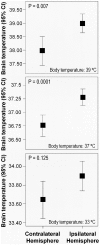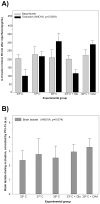Glutamate excitoxicity is the key molecular mechanism which is influenced by body temperature during the acute phase of brain stroke
- PMID: 22952923
- PMCID: PMC3429451
- DOI: 10.1371/journal.pone.0044191
Glutamate excitoxicity is the key molecular mechanism which is influenced by body temperature during the acute phase of brain stroke
Abstract
Glutamate excitotoxicity, metabolic rate and inflammatory response have been associated to the deleterious effects of temperature during the acute phase of stroke. So far, the association of temperature with these mechanisms has been studied individually. However, the simultaneous study of the influence of temperature on these mechanisms is necessary to clarify their contributions to temperature-mediated ischemic damage. We used non-invasive Magnetic Resonance Spectroscopy to simultaneously measure temperature, glutamate excitotoxicity and metabolic rate in the brain in animal models of ischemia. The immune response to ischemia was measured through molecular serum markers in peripheral blood. We submitted groups of animals to different experimental conditions (hypothermia at 33°C, normothermia at 37°C and hyperthermia at 39°C), and combined these conditions with pharmacological modulation of glutamate levels in the brain through systemic injections of glutamate and oxaloacetate. We show that pharmacological modulation of glutamate levels can neutralize the deleterious effects of hyperthermia and the beneficial effects of hypothermia, however the analysis of the inflammatory response and metabolic rate, demonstrated that their effects on ischemic damage are less critical than glutamate excitotoxity. We conclude that glutamate excitotoxicity is the key molecular mechanism which is influenced by body temperature during the acute phase of brain stroke.
Conflict of interest statement
Figures





References
-
- Campos F, Blanco M, Barral D, Agulla J, Ramos-Cabrer P, et al. (2012) Influence of temperature on ischemic brain: basic and clinical principles. Neurochem Int 60: 495–505. - PubMed
-
- Castellanos M, Sobrino T, Pedraza S, Moldes O, Pumar JM, et al. (2008) High plasma glutamate concentrations are associated with infarct growth in acute ischemic stroke. Neurology 71: 1862–1868. - PubMed
-
- Castillo J (1999) Deteriorating stroke: diagnostic criteria, predictors, mechanisms and treatment. Cerebrovasc Dis 9 Suppl 3: 1–8. - PubMed
Publication types
MeSH terms
Substances
LinkOut - more resources
Full Text Sources
Medical

